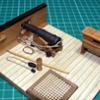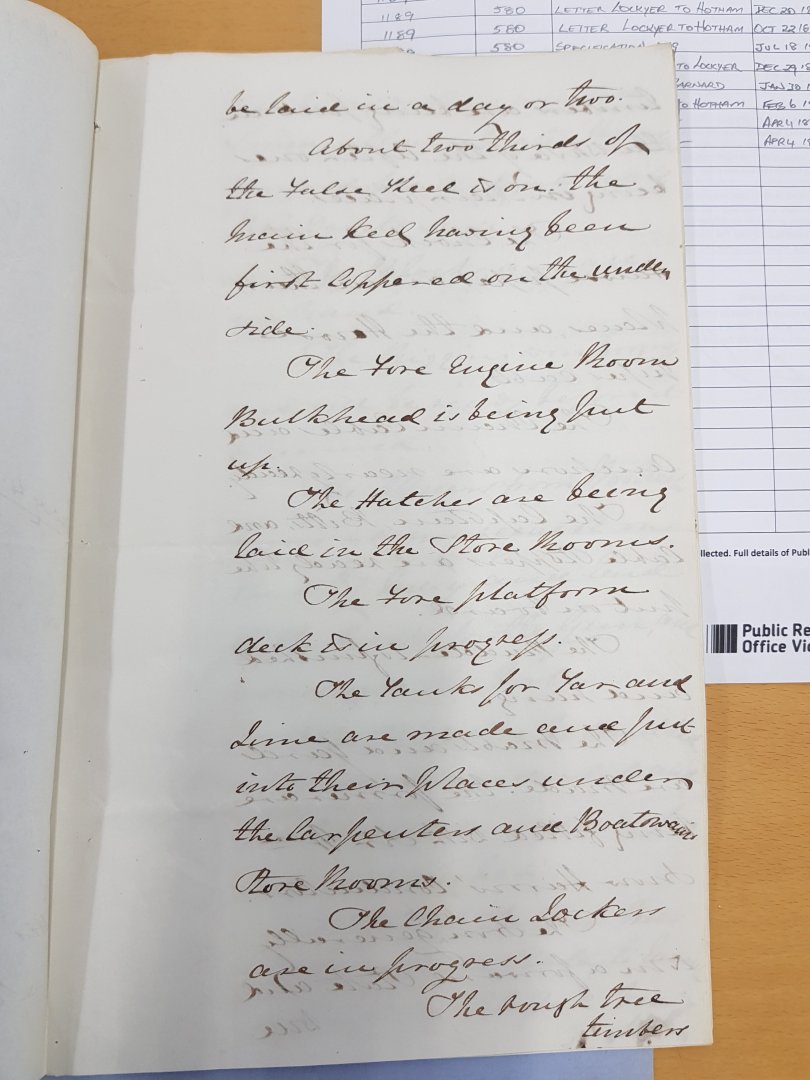-
Posts
5,918 -
Joined
-
Last visited
Content Type
Profiles
Forums
Gallery
Events
Everything posted by BANYAN
-
Been there mate, the doc says I'm two one-eyed cheers Pat
- 301 replies
-
- Constitution
- Bluejacket Shipcrafters
-
(and 1 more)
Tagged with:
-
Nice job on those davits Glen. I had to take a double look to check it was your model or the real deal (the blocks give it away ). cheers Pat
- 301 replies
-
- Constitution
- Bluejacket Shipcrafters
-
(and 1 more)
Tagged with:
-
We used to finish off the tails of the tackle this way when I was in the grey funnel line; a few half hitches around all parts of the falls then simply wrap the remainder. As also suggested, another way was to seize the working part back onto the other parts as shown in this photo I took of the stays in SS Great Britain. cheers Pat
-
Thanks John, I agree - robands and not laced. WRT to these lines I am starting to believe these were entry errors (misnamed) as no leech lines were listed in the Rigging Warrant, but they are clearly evident in most of the lithography (which has proven remarkably accurate). The names start with a 'L" which is no real indicator These lines are listed immediately after the bunt lines (and whips) and before the slab lines, I am seriously starting to think that these will have been the leech lines. cheers Pat
-
Hi all, I am seeking information on some of the sail control lines listed against the fore main course in the Rigging Warrant for HMCSS Victoria (1855) - Barque Rigged. Along with the usual Bunt (+ bunt whips), leech lines and slab lines, there is a listing for 'Lace Lines' (fore course) - 17 fathoms of 1.75" hemp rope with 4 x 5" blocks (assumed to be two per each side of the sail), and 'Lead Lines' (main course) - 19 fathoms of 2" hemp rope with 4 x 5" blocks (assumed to be two per each side of the sail). As these are listed with the other sail control lines I am assuming they are also control lines. I am also assuming that the lines could be called one or the other (i.e. the same line but with different names). I have looked high and low in all the usual rigging books (Lees, Harland, Kipping, Fincham, Nares, Luce etc) with no joy. One thought was that perhaps these were spilling lines but the presence of the blocks sort of precludes this option? Can an anyone shed any light on the purpose and rigging of these lines? Many thanks Pat
-
Well Glen, I hope you have a supply of Saki in to help celebrate the milestones? It certainly looks an interesting hull with those squared off ends. cheers Pat
- 106 replies
-
- Kentoshi-Sen
- bottle
-
(and 1 more)
Tagged with:
-
Another interesting subject here Glen, looking forward to it. cheers Pat
- 106 replies
-
- Kentoshi-Sen
- bottle
-
(and 1 more)
Tagged with:
-
Another interesting subject you are undertaking Greg; look forward to seeing this come along. cheers Pat
- 81 replies
-
- Micromaster
- Eduard
- (and 4 more)
-
She is really looking great Keith, a lot of well crafted unique detail. cheers Pat
- 732 replies
-
- Lula
- sternwheeler
-
(and 1 more)
Tagged with:
-
Paul, I think we should give a little more credence to people working with official records/documents to accurately reflect the intention/content. I take your point that sometimes errors were made, but I think on the whole people working in these institutions try to reflect the content fairly accurately when summarising them. I am certainly finding that with our Records Offices here in Australia (and in NZ). Like Bruce, I have rarely had to address any inaccuracies, but the staff were more than helpful and keen to update the online descriptions when I have raised something. I too am guilty of not trusting many statements on record without seeing them myself; that is where I run into some issues as many people state or quote information with inadequate citation. From a pure personal (selfish) interest, I would love to get access to Hotham's private correspondence which was returned to the UK , but is now available (not digitised) through some library/Uni over there. I have the location but not the means unfortunately As I said my comment is an excerpt from a LETTER from the Build Superintendent (Commander Lockyer RN - an experienced former CO of HMS Medea -on the China Station) to the Governor of Victoria (Captain, Sir Charles Hotham, RN, KCB - a well credentialled Naval Officer of some repute who took a very active interest in Victoria's build and design) - I think that based on Lockyer's comments/first-hand (eyes-on) observation of the vessel as she was built, that it can be taken as an accurate description. That said though, his language is a little ambiguous in that it infers rather than states that the false keel was not coppered. However, he clearly states that the keel was coppered over before the false keel was put on. I attach a copy of the first and relevant page of that letter (see first paragraph of the latter). I am making the assumption that as Lockyer was very particular in pointing things that were done, that the absence of a statement along the lines that "the false keel has been coppered" infers that it wasn't - he was careful to say the underside of the keel had been coppered. These letters, along with an equal number of personal notes from Lockyer to Hotham) were a regular report from Lockyer to Hotham almost on a weekly basis at times). I hope this helps to satisfy your curiosity a little? cheers Pat
-
Very nice work John, she is coming along very well, and I should add congratulations on getting her to the standard the Museum has accepted it. As to ownership/part of collection, I have come across this conundrum down here in Melbourne also. Large donations of models from other organisations/authorities are passed along, but not actually part of the new owners actual collection. Usually they only act as their custodian - we have an area (tunnels really) where there a load of models collecting dust that have not even been listed/identified yet alone curated. Victoria still remains the only State in Australia without an official 'Maritime Museum' - sorry I'll get off my soap box now - sorry to hijack your thread John. cheers Pat
-
Which documents are you referring to Paul, the original identified by Bruce, or the one I refer to. If mine, it is a letter, not so much a document. The original record is held in the Public Records Office of Victoria (PROV) Australia. I provided the path/location at the bottom of my post, but it is not digitized and can only be read in their premises unfortunately. If Bruce's original find, he provided the link, as does Thukydides above, as you can see below, the comment is merely a small part of the 'summary' of the document, not the actual document as it also has not been digitized. If anyone actually goes in and finds this document, I would appreciate a copy. cheers Pat
-
Yeah mate, absolutely a compliment: "The jocular Australian-English expression 'the ant’s pants' denotes an outstandingly good thing" The model is looking great and you've done a grand job with it. WRT the cows and snakes (and other critters crawling or slithering) - well they don't get too much to eat in our outback paddocks - so this is sort of a 'dietary supplement' Maybe you should start feeding these to your herd? They may not be so skittish about those 'B' words cheers Pat
- 301 replies
-
- Constitution
- Bluejacket Shipcrafters
-
(and 1 more)
Tagged with:
-
Dan, based on a letter (report) written by the ship's build superintendent (Commander Lockyer, RN) to the Governor (Hotham) of 4 June 1855, about the progress of HMCSS Victoria's (1855) construction: … About two thirds of the False Keel is on, the main Keel having been first coppered on the underside, ... This suggests, that least in 1850s, the coppering passed under the keel but the false keel (Lang's safety keel in this instance) was not coppered. Not for the exact time period you are looking at, but I hope this helps? cheers Pat [i] PROV; VA 475; VPRS 1189/P0000; 580, Unregistered Correspondence; Lockyer second Letter to Hotham, 4 June 1855.
-
Nice recovery on the trysail mast and rigging Glen, she is looking 'the ants pants' Also happy to hear you were able to celebrate in style. I must add that I hope "your chooks don't turn into emus and kick your dunny down" - sorry folks an in-joke based on a very corny Aussie song - you really don't need some oversized chickens running amok when working on this little beauty. cheers Pat
- 301 replies
-
- Constitution
- Bluejacket Shipcrafters
-
(and 1 more)
Tagged with:
-
Great photos and some significant progress on the rigging Glen. You're doing a great job with her. Enjoying following along with your rigging journey. cheers Pat
- 301 replies
-
- Constitution
- Bluejacket Shipcrafters
-
(and 1 more)
Tagged with:
-
WRT the lanyards, they were possibly 'white rope' which is a general term for untarred plain-laid natural fibre rope; it can be of any type including jute, manilla or sisal hemp. According to Luce (1868), page 49, white rope is used for lead and log lines, ensign, pennant and signal halliards; and for making block straps and tackle/purchase falls. Trevor may have better information as to whether used with deadeyes though. cheers Pat
-
Great info; many thanks for posting Pat
-
Absolutely stunning 'smithing' Ilhan - they look great. A very well executed bit of metalwork. cheers Pat
-
I found the local Railroad Modelling clubs to be the best source as they do a lot of PE in making their locos and rolling stock. cheers Pat
About us
Modelshipworld - Advancing Ship Modeling through Research
SSL Secured
Your security is important for us so this Website is SSL-Secured
NRG Mailing Address
Nautical Research Guild
237 South Lincoln Street
Westmont IL, 60559-1917
Model Ship World ® and the MSW logo are Registered Trademarks, and belong to the Nautical Research Guild (United States Patent and Trademark Office: No. 6,929,264 & No. 6,929,274, registered Dec. 20, 2022)
Helpful Links
About the NRG
If you enjoy building ship models that are historically accurate as well as beautiful, then The Nautical Research Guild (NRG) is just right for you.
The Guild is a non-profit educational organization whose mission is to “Advance Ship Modeling Through Research”. We provide support to our members in their efforts to raise the quality of their model ships.
The Nautical Research Guild has published our world-renowned quarterly magazine, The Nautical Research Journal, since 1955. The pages of the Journal are full of articles by accomplished ship modelers who show you how they create those exquisite details on their models, and by maritime historians who show you the correct details to build. The Journal is available in both print and digital editions. Go to the NRG web site (www.thenrg.org) to download a complimentary digital copy of the Journal. The NRG also publishes plan sets, books and compilations of back issues of the Journal and the former Ships in Scale and Model Ship Builder magazines.










